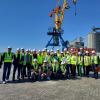Search
Displaying Results 1 - 15 of 15
Landlocked developing countries (LLDCs) face many complex challenges. Due to their geographic remoteness, their lack of direct access to the open sea and the high transport and transit costs they face, they are at a significant economic disadvantage compared to the rest of the world. The Euro-
The launch of an eTIR pilot project between Georgia and Turkey kick-started in Tbilisi, Georgia, on 5 March. The aim of this project is to further facilitate legitimate trade and transport between both countries through an extended use of information and communication technologies and to
The World Forum for the harmonization of vehicle regulations has been adopting regulations on vehicles’ emission levels for decades. It is now looking into a new issue: vehicles interior air quality. The issue was raised at the initiative of the Republic of Korea, following media reports
The transport costs of the world`s 32 Landlocked Developing Countries (LLDCs) are on average 50% higher than developing countries that have access to the open sea. If containerized imports are considered, LLDCs have costs that are 85% higher than the world average. As a result, LLDC exports are
Many incidents in freight transport are attributed to poor practices in the packing of freight containers, including inadequate securing of cargo, overloading and incorrect declaration of contents. The victims of these incidents may be the general public or transport and supply chain workers, who
Participants in the motor industry’s complex supply chains, regulators as well as investors seeking to invest sustainably are increasingly interested in considering the carbon footprint of vehicles over their entire lifetime - from material extraction and production to manufacturing, use and
The effects of economic growth and increasing population in urban areas are challenging many countries, including those that historically have been integrating human settlements in a naturalistic environment, like Lithuania.To address these challenges, the Kaunas City Municipality and the
Each year, around 1.24 million people die in road accidents. A disproportionate amount of the deaths on the roads (90%) occurs in low- and middle-income countries, despite these countries accounting for just 54% of the world’s road vehicles. Most of these deaths are due to the lack of basic
Discussions on the future of transportation are often dominated by headline-grabbing ideas: autonomous or electric vehicles, intelligent transport systems focusing on mobility services; ever-faster high-speed trains. Within this debate bus transport is often an unfashionable afterthought, a
Every year 1.25 million people die in road traffic accidents while an additional 50 million are injured. 500 children lose their lives on the road every single day, with road traffic accidents representing the leading cause of death for young people aged 15 to 29. With these numbers
The mandatory wearing of safety-belts in cars first introduced in Europe at the turn of the 1970s has saved millions of lives around the world in the past 50 years.
According to the World Health Organization, the use of safety-belts by occupants of vehicles in front seats reduces the risk of
Inland transport plays a crucial role in the global economy, connecting people, goods and services to markets and opportunities. However, the rapid growth in this sector has had a significant impact on the environment. The increasing demand for faster and more efficient modes of transport has led
In Paraguay, road accidents are the leading cause of death in adolescents and young people aged 15 to 29 – a situation that has got worse over the last five years, according to WHO. The country also leads the list of deaths due to road accidents of motorcycle drivers and their companions in
Economic growth and effective transport connectivity are closely interrelated in the vast Euro-Asian landmass. Taking advantage of the significant and greatly under-utilized transit capacity of land routes through Eurasia can not only provide more transport options for trade, but also boost
As transport technology progresses at breath-taking speed we tend to focus on how advanced and intelligent vehicles are getting. However, of equal importance is the infrastructure that they travel on and where new technology can be used to make these roads more secure, safe, efficient and





